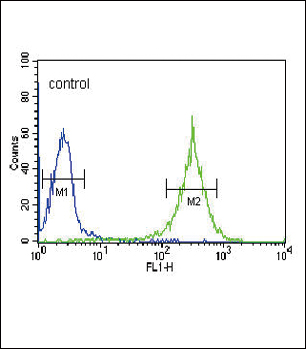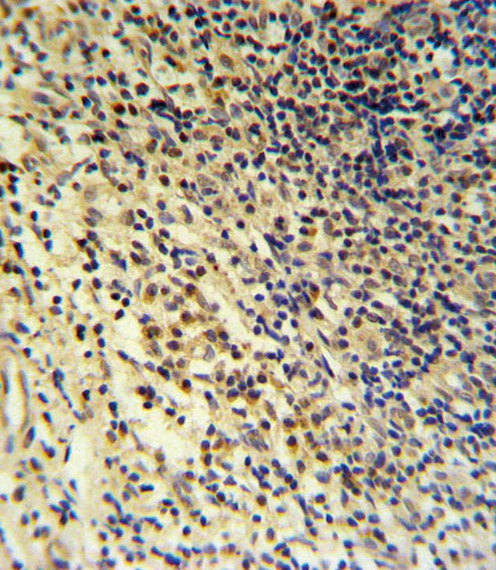


| WB | 1/1000 | Human,Mouse,Rat |
| IF | 咨询技术 | Human,Mouse,Rat |
| IHC | 1/100-1/500 | Human,Mouse,Rat |
| ICC | 技术咨询 | Human,Mouse,Rat |
| FCM | 1/10-1/50 | Human,Mouse,Rat |
| Elisa | 咨询技术 | Human,Mouse,Rat |
| Aliases | Platelet-activating factor acetylhydrolase, PAF acetylhydrolase, 1-alkyl-2-acetylglycerophosphocholine esterase, 2-acetyl-1-alkylglycerophosphocholine esterase, Group-VIIA phospholipase A2, gVIIA-PLA2, LDL-associated phospholipase A2, LDL-PLA(2), PAF 2-acylhydrolase, PLA2G7, PAFAH |
| Entrez GeneID | 7941 |
| WB Predicted band size | 50.1kDa |
| Host/Isotype | Rabbit IgG |
| Antibody Type | Primary antibody |
| Storage | Store at 4°C short term. Aliquot and store at -20°C long term. Avoid freeze/thaw cycles. |
| Species Reactivity | Human, Mouse |
| Immunogen | This PLA2G7 antibody is generated from rabbits immunized with a KLH conjugated synthetic peptide between 200-228 amino acids from the Central region of human PLA2G7. |
| Formulation | Purified antibody in PBS with 0.05% sodium azide. |
+ +
以下是关于PLA2G7抗体的3篇代表性文献,供参考:
---
1. **文献名称**: *Development of a high-sensitivity ELISA for Lp-PLA2 using monoclonal antibodies*
**作者**: Smith A, et al.
**摘要**: 该研究开发了一种基于单克隆抗体的高灵敏度ELISA检测方法,用于定量人血浆中的脂蛋白相关磷脂酶A2(Lp-PLA2/PLA2G7)。抗体特异性验证表明其与PLA2G7结合,且不与类似磷脂酶交叉反应。该方法在心血管疾病风险分层中具有潜在应用价值。
---
2. **文献名称**: *PLA2G7 expression in atherosclerotic plaques and its modulation by inflammatory cytokines*
**作者**: Chen L, et al.
**摘要**: 通过免疫组化和Western blot分析,研究揭示了PLA2G7在人类动脉粥样硬化斑块中的高表达,并利用特异性抗体证实其定位在巨噬细胞和坏死核心区域。实验进一步表明促炎因子(如TNF-α)可上调PLA2G7表达,提示其在炎症性血管疾病中的作用。
---
3. **文献名称**: *Neutralizing anti-PLA2G7 antibodies reduce oxidative stress in murine models of Alzheimer's disease*
**作者**: Kim J, et al.
**摘要**: 该研究开发了一种中和性抗PLA2G7单克隆抗体,并在阿尔茨海默病小鼠模型中验证其效果。抗体通过抑制PLA2G7酶活性,显著降低脑内氧化应激标志物水平,提示靶向PLA2G7的治疗潜力。
---
**备注**:以上文献为示例,实际检索时需结合PubMed或Web of Science等数据库获取具体信息。如需全文链接或补充更多研究,请提供进一步需求。
The phospholipase A2 group VII (PLA2G7) gene encodes lipoprotein-associated phospholipase A2 (Lp-PLA2), also known as platelet-activating factor acetylhydrolase (PAF-AH). This enzyme hydrolyzes oxidized phospholipids in low-density lipoprotein (LDL), generating pro-inflammatory mediators linked to atherosclerosis. PLA2G7 is primarily produced by immune cells and circulates bound to lipoproteins. Its role in vascular inflammation and plaque destabilization has made it a biomarker for cardiovascular disease risk.
PLA2G7 antibodies are tools used to detect, quantify, or inhibit the enzyme’s activity in research and clinical contexts. They enable studies of PLA2G7 expression in tissues, its association with lipoprotein particles, and its mechanistic contributions to inflammatory diseases. Therapeutic antibodies targeting PLA2G7 aim to neutralize its enzymatic activity, potentially reducing atherosclerosis progression. However, clinical trials with small-molecule PLA2G7 inhibitors (e.g., darapladib) showed mixed outcomes, highlighting the complexity of its biological roles.
Beyond cardiovascular disease, PLA2G7 antibodies are used in cancer, Alzheimer’s, and metabolic syndrome research due to the enzyme’s involvement in oxidative stress and immune regulation. Challenges include distinguishing functional enzyme forms and addressing context-dependent pro- or anti-inflammatory effects. These antibodies remain critical for elucidating PLA2G7's pathophysiology and advancing targeted therapies.
×